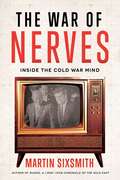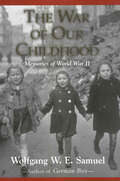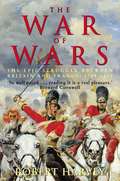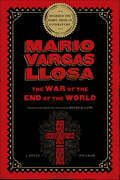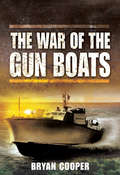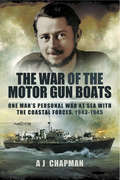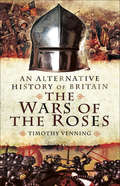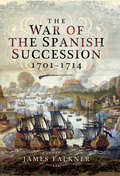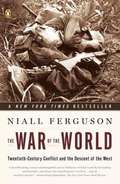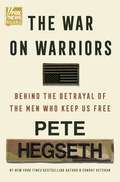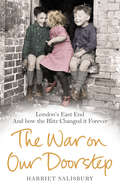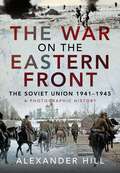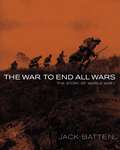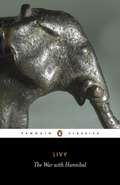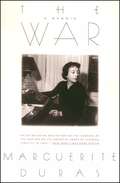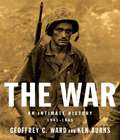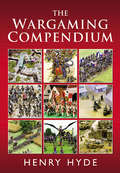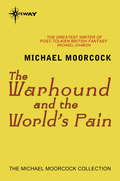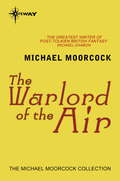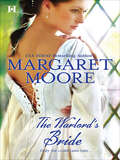- Table View
- List View
The War of Nerves: Inside the Cold War Mind
by Martin SixsmithA major new history of the Cold War that explores the conflict through the minds of the people who lived through it.More than any other conflict, the Cold War was fought on the battlefield of the human mind. And, nearly thirty years since the collapse of the Soviet Union, its legacy still endures—not only in our politics, but in our own thoughts and fears. Drawing on a vast array of untapped archives and unseen sources, Martin Sixsmith vividly recreates the tensions and paranoia of the Cold War, framing it for the first time from a psychological perspective. Revisiting towering, unique personalities like Khrushchev, Kennedy, and Nixon, as well as the lives of the unknown millions who were caught up in the conflict, this is a gripping narrative of the paranoia of the Cold War—and in today's uncertain times, this story is more resonant than ever.
The War of Our Childhood: Memories of World War II
by Colonel Wolfgang W. SamuelOne survivor tells of the fire-bombing of Dresden. Another survivor recounts the pervasive fear of marauding Russian and Czech bandits raping and killing. Children recall fathers who were only photographs and mothers who were saviors and heroes. These are typical in the stories collected in The War of Our Childhood: Memories of World War II. For this book Wolfgang W. E. Samuel, a childhood refugee himself after the fall of Nazi Germany, interviewed twenty-seven men and women who as children—by chance and sheer resilience—survived Allied bombs, invading armies, hunger, and chaos. “Our eyes carried no hate, only recognition of what was,” Samuel writes of his childhood. “Peace was an abstraction. The world we Kinder knew nearly always had the word ‘war’ appended to it.” Samuel's heartfelt narratives from these innocent survivors are invariably riveting and often terrifying. Each engrossing story has perilous and tragic moments—school children in Leuna who are sent home during an air raid but are strafed as moving targets; fathers who exist only as distant figures, returning to their families long after the war—or not at all; mothers who are raped and tortured; families who are forced into a seemingly endless relocation that replicates the terrors of war itself. In capturing such experiences from nearly every region of Germany and involving people of every socio-economic class, this is a collection of unique memories, but each account contributes to a cumulative understanding of the war that is more personal than strategic surveys and histories. For Samuel and the survivors he interviewed, agony and fright were part of everyday life, just as were play, wondrous experience, and above all perseverance. “My focus,” Samuel writes, “is on the astounding ability of a generation of German children to emerge from debilitating circumstances as sane and productive human beings.”
The War of Wars: The Epic Struggle Between Britain And France, 1789-1815 (Social And Economic Studies Of Post-war France Ser.)
by Robert HarveyRobert Harvey brilliantly recreates the story of the greatest conflict that stretches from the first blaze of revolution in Paris in 1789 to final victory on the muddy fields of Waterloo.On land and at sea, throughout the four corners of the continent, from the frozen plains surrounding Moscow and terror on the Caribbean seas, to the muddy low lands of Flanders and the becalmed waters of Trafalgar, The War of Wars tells the powerful story of the greatest conflict of the age.
The War of Wars: The Epic Struggle Between Britain and France: 1789-1815 (Social And Economic Studies Of Post-war France Ser.)
by Robert HarveyRobert Harvey brilliantly recreates the story of the greatest conflict that stretches from the first blaze of revolution in Paris in 1789 to final victory on the muddy fields of Waterloo.On land and at sea, throughout the four corners of the continent, from the frozen plains surrounding Moscow and terror on the Caribbean seas, to the muddy low lands of Flanders and the becalmed waters of Trafalgar, The War of Wars tells the powerful story of the greatest conflict of the age.
The War of the End of the World: A Novel
by Mario Vargas LlosaThe Nobel Prize–winning author’s classic novel of civil war in nineteenth-century Brazil: “A modern tragedy on the grand scale . . . As dark as spilled blood” (Salman Rushdie, The New Republic).Deep within the remote backlands of Brazil lies Canudos, home to all the damned of the earth: prostitutes, bandits, beggars, and every kind of outcast. It is a place where history and civilization have been wiped away. There is no money, no taxation, no marriage, no census. Canudos is a cauldron for the revolutionary spirit in its purest form, a state with all the potential for a true, libertarian paradise—and one the Brazilian government is determined to crush at any cost.In perhaps his most ambitious and tragic novel, Mario Vargas Llosa offers his fictionalized vision of the story of Canudos, inhabiting characters on both sides of the massive, cataclysmic battle between the society and government troops. The resulting novel is a fable of Latin American revolutionary history, an unforgettable story of passion, violence, and the devastation that follows from fanaticism.
The War of the Gun Boats
by Bryan CooperThe 'little ships' of the Second World War - the fast and highly maneuverable motor torpedo boats and gunboats which fought in coastal waters all over the world - developed a special kind of naval warfare. With their daring nightly raids against an enemy's coastal shipping - and sometimes much larger warships - they acquired the buccaneering spirit of an earlier age. And never more so than in the close hand-to-hand battles which raged between opposing craft when they met in open waters.Large numbers of these small fighting boats were built by the major naval powers. The Germans called them Schnellboote (Fast Boats), referred to by the British as E-boats (E for Enemy). In the Royal Navy they were MTBs and MGBs. The American equivalent were PT boats (for Patrol Torpedo). They fought in the narrow waters of the English Channel and the stormy North Sea, in the Mediterranean off the coasts of North Africa and Italy and among the islands of the Aegean, across the Pacific from Pearl Harbour to Leyte Gulf, in Hong Kong and Singapore, and off Burma's Arakan coast.Bryan Cooper's book traces the history and development of these craft from their first limited use in the First World War and the fast motor boats designed in the 1930s for wealthy private clients and water speed record attempts. With account of the battles which took place during the Second World War, when the vital importance of coastal waters came to be recognized, he captures the drama of this highly individual form of combat. And not least the sea itself which was the common enemy of all who crewed these frail craft.
The War of the Motor Gun Boats: One Man's Personal War at Sea with the Coastal Forces, 1943–1945
by A. J. ChapmanTony Chapman was born in Southampton in 1924. Aged 16 he watched with horror as the historic High Street of Southampton burnt to the ground in a firestorm caused by a heavy German bombing raid on the night of 30 November 1940. He vowed to join up and fight back. Tony joined the Navy.Within hours of being posted to his first Motor Gun Boat, Telegraphist Tony Chapman was involved in an epic Coastal Forces engagement when his flotilla took on a force of thirty E-boats. Although their unit of two MGBs sank three E-Boats, it was at a high cost. Half of Tony's shipmates were killed or injured.This was the start of an eventful and dramatic wartime service with these little warships. Tony's flotilla operated in the Mediterranean and Aegean where the Motor Gun Boats played a key role in this important but often neglected theatre.rnDaily life on these small ships is vividly described. The flotilla had a busy time showing the flag in the Levant and on combined operations in the Aegean with the Greek Sacred Regiment of Commandos. The culmination of their efforts was when Tony's boat, ML838, took the surrender of the Island of Kos in 1945.rnrnWritten from the perspective of one of the other ranks, War of the Motor Gun Boats fills an important gap in the literature of the Second World War.As featured in the North Devon Journal and Exmoor Magazine.
The War of the Roses: An Alternative History of Britain
by Timothy VenningTimothy Venning's exploration of the alternative paths that British history might easily have taken moves on to the Wars of the Roses. What if Richard of York had not given battle in vain? How would a victory for Warwick the Kingmaker at the Battle of Barnet changed the course of the struggle for power? What if the Princes had escaped from the tower or the Stanleys had not betrayed their king at Bosworth? These are just a few of the fascinating questions posed by this book. As always, while necessarily speculative, Dr. Venning discusses all the scenarios within the benefit of a deep understanding of the major driving forces, tensions and trends that shaped British history. In so doing, he helps the reader to understand why things panned out as they did, as well as what might have been in this tumultuous period.
The War of the Running Dogs: How Malaya Defeated The Communist Guerrillas, 1948-1960 (Sven Hassel War Classics)
by Noel Barber'The story of the first all-out struggle in Asia between Communism and the West, vividly told in an exciting and engrossing book' Sunday ExpressOnly three short years after the end of the Japanese occupation, war came again to Malaya. The Chinese-backed guerrillas called it the War of the Running Dogs - their contemptuous term for those in Malaya who remained loyal to the British. The British Government referred to this bloody and costly struggle as the 'Malayan Emergency'. Yet it was a war that lasted twelve years and cost thousands of lives. By the time it was over Malaya had obtained its independence - but on British, not on Chinese or Communist terms. Here is the war as it was. Here are the planters and their wives on their remote rubber estates, the policemen, the generals and the soldiers, the Malays, Chinese and Indians of a polyglot country, all fighting an astute, ruthless, and well organized enemy.
The War of the Running Dogs: Malaya 1948-1960 (W&N Military)
by Noel Barber'The story of the first all-out struggle in Asia between Communism and the West, vividly told in an exciting and engrossing book' Sunday ExpressOnly three short years after the end of the Japanese occupation, war came again to Malaya. The Chinese-backed guerrillas called it the War of the Running Dogs - their contemptuous term for those in Malaya who remained loyal to the British. The British Government referred to this bloody and costly struggle as the 'Malayan Emergency'. Yet it was a war that lasted twelve years and cost thousands of lives. By the time it was over Malaya had obtained its independence - but on British, not on Chinese or Communist terms. Here is the war as it was. Here are the planters and their wives on their remote rubber estates, the policemen, the generals and the soldiers, the Malays, Chinese and Indians of a polyglot country, all fighting an astute, ruthless, and well organized enemy.
The War of the Spanish Succession, 1701–1714
by James FalknerHow the death of a childless monarch sparked a bloody conflict that raged across Europe and beyond. The War of the Spanish Succession, fought between 1701 and 1714 to decide who should inherit the Spanish throne, was a conflict on an unprecedented scale, stretching across most of western Europe, the high seas, and the Americas. Yet this major subject is not well known and little understood. James Falkner's absorbing new study fills that gap. In a clear and perceptive narrative, he describes and analyzes the complex political maneuvers and a series of military campaigns, which also involved the threat posed by Ottoman Turks in the east and Sweden and Russia in the north. Fighting took place not just in Europe but in the Americas and Canada, and on the high seas. All European powers, large and small, were involved—France, Spain, Great Britain, Holland, Austria and Portugal were the major players. The end result of over a decade of outright war was a French prince firmly established on the throne in Madrid and a division of the old Spanish empire. More notably though, French power, previously so dominant, was curbed for almost ninety years.
The War of the World: Twentieth-Century Conflict and the Descent of the West
by Niall FergusonAstonishing in its scope and erudition, this is the magnum opus that Niall Ferguson's numerous acclaimed works have been leading up to. In it, he grapples with perhaps the most challenging questions of modern history: Why was the twentieth century history's bloodiest by far? Why did unprecedented material progress go hand in hand with total war and genocide? His quest for new answers takes him from the walls of Nanjing to the bloody beaches of Normandy, from the economics of ethnic cleansing to the politics of imperial decline and fall. The result, as brilliantly written as it is vital, is a great historian's masterwork.
The War of the Worlds (Adapted Version)
by H. G. Wells Mary Ann EvansWhen a spaceship from Mars lands on Earth, people try to welcome the alien visitors at first. When the Martians start killing the humans, will Earth be ready for the war of the worlds?
The War on Truth: Everything You Ever Wanted to Know About the Invasion of Iraq but Your Government Wouldn't Tell You
by Neil MackayThe War on Truth investigates all aspects of the lead up to the war in Iraq, its execution, and its aftermath. Neil MacKay contends that the public was systematically fed untruths in a manner that questions what kind of democracy we really have. MacKay, award winning investigative journalist for Scotland&’s Sunday Herald newspaper has covered the West&’s intelligence agencies for many years. In this book he questions why &‘intelligence&’ missed 9/11 and why the best funded intelligence networks in history got things so badly wrong. The WMD debate is also covered. MacKay&’s extensive contacts in the intelligence community make a telling contribution to this investigation and we see an intimate picture of how intelligence is gathered, how it is interpreted and why things go wrong. We also gain an insight to Neo–Cons, the radical think tank that surround George W. Bush and some of whom stated before 9/11, that the US &“needed another Pearl Harbor&” to condition the American people (and their allies) into supporting war against Saddam Hussein. Author Neil MacKay is a three–times finalist as British Reporter of tile Year in the British Press Awards, Britain&’s equivalent of the Pulitzer Prize. MacKay revealed the identity of the Omagh bomber, exposed the British Army colonel who used loyalist terrorists as proxy assassins throughout the &“Troubles&” in Northern Ireland and unmasked &“Stakeknife&”, the highest-ranking British army spy inside the IRA. His investigations into the war on terror and the invasion of lraq have won international acclaim. More than 200,000 US readers regularly turn to his stories on the internet every Sunday. In 1999, MacKay famously wrote an article based on briefings with CIA operatives in Pakistan that reported that aI-Qaeda and Osama bin Laden planned to use planes to attack mainland America. He has appeared on TV and radio regularly as a commentator in the UK, France. Italy. Japan. America. Canada, South America, Australia, New Zealand, Germany and throughout the Middle East. John Pilger: &“Neil&’s masterly and prodigious scoops are the stuff of newspaper legend&” Truthout.org: &“the gold standard of investigative journalists&”
The War on Warriors: Behind the Betrayal of the Men Who Keep Us Free
by Pete HegsethReal men fought for our freedoms. It’s time we fought for theirs. <P><P> Pete Hegseth joined the Army to fight extremists. Then that same Army called him one. The military Pete joined twenty years ago was fiercely focused on lethality, competency, and color blindness. Today our brass are following the rest of our country off the cliff of cultural chaos and weakness. <P><P> Americans with common sense are fighting this on many fronts, but if we can’t save the meritocracy of our military, we’re definitely going to lose everywhere else. <P><P> The War on Warriors uncovers the deep roots of our dysfunction—a society that has forgotten the men who take risks, cut through red tape, and get their hands dirty. The only kind of men prepared to face the dangers that the Left pretends don’t exist. Unlike issues of education or taxes or crime, this problem doesn’t have a zip code solution. We can’t move away from it. We can’t avoid it. We have only one Pentagon. Either we take it back or surrender it altogether. <P><P> Combining his own war experiences, tales of outrage, and an incisive look at how the chain of command got so kinked, this book is the key to saving our warriors—and winning future wars. The War on Warriors must be won by the good guys, because when the shooting really starts, they’re the only ones who can save us. <p> <b>New York Times Bestseller</b>
The War on our Doorstep: London's East End and how the Blitz Changed it Forever
by Harriet Salisbury The Museum of London GroupLondon's East Enders are known for being a tough, humorous and lively lot. In the early 20th century, families crowded into single rooms, children played on the streets and neighbours' doors were never locked in case you needed an escape route from the police...World War 2 changed everything. During the Blitz, men set off for work never to return and rows of houses were reduced to rubble overnight. Yet the East Enders' ability to keep calm and carry on cemented their reputation for cheerful resilience. They say Hitler killed off the bugs but, along with the slums, the Blitz destroyed a way of life. After the war families were scattered - some to estates on the edge of London, others to isolated high-rise blocks. The old East End communities were gone forever.Told by the residents themselves, The War on Our Doorstep is an eye-opening, moving and laugh-out-loud depiction of the history of London's East End and what it means to be an East Ender.
The War on the Eastern Front: The Soviet Union, 1941-1945 - A Photographic History
by Alexander HillThe RIA-Novosti press agency – now known as Sputnik in the West – has one of the best archives of Soviet Second World War photographs and for this remarkable book Alexander Hill has made a superb selection of them. These striking images record vividly, as only photographs can, the brutal conflict on the Eastern Front and the extraordinary experience of the soldiers and civilians who were caught up in it. Every aspect of the struggle is depicted – the fighting on the front lines and behind the lines, aerial combat and naval warfare, the ordeal of living under German occupation, the war industries and Lend-Lease and the massive sacrifices made at every level of Soviet society to defeat the Germans. The photographs and captions take the reader through the entire course of the war, from the Nazi-Soviet Pact and Soviet expansion into Poland, Finland and the Baltic Republics, through Operation Barbarossa and the German advances of 1941 and 1942, to the momentous battles at Stalingrad and Kursk and the sequence of massive offensives mounted by the Red Army that drove the Wehrmacht back to Berlin. The landscapes over which the armies moved, and the shattered towns and cities they left behind, are recorded as are individuals whose faces were captured by the camera during this devastating conflict over seventy years ago.
The War to End All Wars: The Story of World War I
by Jack BattenA brilliant, concise history of The War to End All Wars. In the decade leading up to 1914, Europe had never known such prosperity. But the times were not good enough for the continent's most powerful nations: Germany wanted a navy that matched England's; Russia wanted an army as large and as disciplined as Germany's; the Austro-Hungarian Empire wanted more respect; and England felt compelled to teach the others about civilized relations. How terrible could a war be? In this riveting account of a tragic episode in world history, author Jack Batten takes readers through a far bloodier conflict than mankind had ever before endured. Meet the soldiers who fought the deadly battles along the Western Front. Follow the trail of flying ace Billy Bishop as he tangles in the air with the Red Baron. Learn the strategy of Britain's Grand Fleet of warships as it heads into the biggest sea battle in history. Discover how civilians decoded virtually all the messages the Germans sent to their ships around the world. From the Battle of the Somme, Gallipoli, Passchendale, and Vimy Ridge to the war's final battles, The War to End All Wars evokes the heroism and suffering of men from every country, whose stories changed the face of the world forever. With index and selected bibliography.
The War with Hannibal (Books XXI-XXX of the History of Rome from its Foundation)
by Titus LivyThe author gives us a chronological account about the events of the Second Punic War between Rome and Carthage. Translated by Aubrey De Selincourt.
The War: A Memoir
by Barbara Bray Marguerite DurasAn elegant new paperback edition of one of Marguerite Duras's most important books. Written in 1944 and first published in 1985, Duras's riveting account of life in Paris during the Nazi occupation and the first months of liberation depicts the harrowing realities of World War II-era France "with a rich conviction enhanced by [a] spare, almost arid, technique" (Julian Barnes,The Washington Post Book World). Duras, by then married and part of a French resistance network headed by François Mitterand, tells of nursing her starving husband back to health after his return from Bergen-Belsen, interrogating a suspected collaborator, and playing a game of cat and mouse with a Gestapo officer who was attracted to her. The result is "more than one woman's diary. . . [it is] a haunting portrait of a time and a place and also a state of mind" (The New York Times).
The War: An Intimate History 1941-1945
by Geoffrey C. Ward Ken BurnsThe American experience of World War II captured in the words and deeds, thoughts and feelings of those who made history on the battlefields and on the home front.
The Wargaming Compendium
by Henry HydeAn extensive reference guide to the exciting hobby, for beginners as well as longtime players. Wargaming is a fascinating, engrossing, and exciting pastime that encompasses a wide range of different talents. The average wargamer uses the skills of artist, designer, sculptor, illustrator, historian, librarian, researcher, mathematician, and creative writer, as well as the more obvious ones of general, admiral, or air marshal for large games, or perhaps lieutenant, commodore, or squadron leader for skirmishes. Aside from calling upon many skills, wargaming also covers many aspects of combat, spanning the history of Earth. With science fiction gaming, we plunge into imagined worlds many thousands of years into the future, and a fantasy gamer, of course, deals with eons of imagined history, as anyone who has read The Lord of the Rings will know. A wargamer may find themselves recreating an encounter between a handful of adversaries one day, or a massed battle involving perhaps hundreds of miniature troops the next. Moreover, it is possible to play wargames that recreate warfare on land, on sea, in the air, or even in outer space. This book demonstrates the wonderfully varied hobby of wargaming with miniatures, looking at the broad scope of what it has to offer as well as detailed explanations of how to get involved, including comprehensive rules for gladiator combat, Wild West skirmishes, and the horse and musket era, as well as lots of advice for anyone new to wargaming. Whether you&’re a complete newcomer to the hobby, or a veteran of many years, you&’ll find plenty in The Wargaming Compendium to entertain and inspire you.
The Warhound and the World's Pain
by Michael MoorcockThis is the story of Ulrich von Bek, a cynical mercenary who sells his skills as a soldier in the wars taking place all over Europe. After the particularly horrific destruction of a city in which he played a role, von Bek decides to desert the military company he was working for and travel alone for awhile before seeking further employment. On his solo journey, he happens upon a castle where he takes refuge with - and then falls in love with - the keeper of the castle, the beautiful Sabrina. It is in this castle that he meets Lucifer, the master of Hell, and finds out that his soul is already destined for Hell. And so, in exchange for his soul, von Bek agrees to go on a quest for Lucifer, namely to find the Cure for the World's Pain. This quest is also known as the Search for the Holy Grail.
The Warlord of the Air
by Michael MoorcockIt is 1973, and the stately airships of the Great Powers hold benign sway over a peaceful world. The balance of power is maintained by the British Empire - a most equitable and just Empire, ruled by the beloved King Edward VIII. A new world order, with peace and prosperity for all under the law. Yet, moved by the politics of envy and perverse utopianism, not all of the Empire's citizens support the marvelous equilibrium.Flung from the North East Frontier of 1902 into this world of the future, Captain Oswald Bastable is forced to question his most cherished ideals, discovering to his horror that he has become a nomad of the time streams, eternally doomed to travel the wayward currents of a chaotic multiverse.The first in the trilogy, The Warlord of the Air sees Bastable fall in with the anarchists of this imperial society and set in train a course of events more devastating than he could ever have imagined.
The Warlord's Bride (Mills And Boon M&b Ser.)
by Margaret MooreThe king of England offers a traitor’s widow to the Welsh warrior who captured her husband in this medieval romance by a USA Today–bestselling author.Lady Roslynn knows not what to expect of her future husband, the infamous “Bear of Brecon.” Offered in marriage to the powerful Welsh lord by the king, Roslynn fears the worst. She has no right to hope for a love match, but in her heart the lady dreams of a home and family of her very own.One look at Lord Madoc of Llanpowell makes her blood run hot. The rugged warrior proves a passionate lover and attentive husband—but too soon turns cold and aloof. And when secrets from Madoc’s past threaten to take him away from his bride, Roslynn knows their future together is at stake. Can she uncover the truth beneath her warlord’s armor and lay siege to his heart?Praise for The Warlord’s Bride“A colorfully rendered portrait of medieval Wales brimming with charming characters, an enchanting love story and the perfect balance of romance and history.” —Romantic Times
